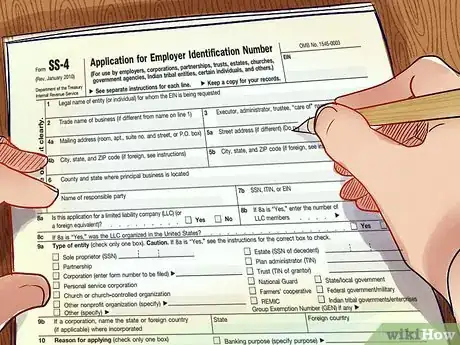wikiHow is a “wiki,” similar to Wikipedia, which means that many of our articles are co-written by multiple authors. To create this article, 39 people, some anonymous, worked to edit and improve it over time.
wikiHow marks an article as reader-approved once it receives enough positive feedback. This article received 25 testimonials and 93% of readers who voted found it helpful, earning it our reader-approved status.
This article has been viewed 438,163 times.
Learn more...
Congratulations! You're joining parents and teachers around the world who want to reinvent education by starting their own schools. Starting a school and sharing your vision for education with the world can be one of the most satisfying career choices you'll make. But where to start? A bit of planning is essential at all steps in the process, but there is also so much support available to you.
Steps
Developing Curriculum
-
1Develop a compelling educational vision. A compelling vision is essential to guide you through the startup phase and beyond. Your vision will drive decisions and actions in the short-and long-term. Envision your school.[1] Consider the following questions:
- What are your values?
- Who do you want to serve?
- What kind of education does this community need?
- What will your school provide that other schools cannot?
- What kind of social, intellectual and emotional experience do you want to give your students?
- Where do you want your school to be in 5 years, 25 years and 100 years?
- What type of school do you want to start? For-profit or non-profit? Non-profits are extremely difficult to establish but have long-term benefits. If you want to start on a smaller scale, you could consider beginning with a few afterschool classes, a part-time homeschool coop or a playgroup.
-
2Write out a curriculum. When writing a curriculum, you need to consider both the practical organizational matters of day-to-day operations, as well as the scope and sequence of learning you hope your school to achieve.[2] A well-written curriculum should address the following categories of information:
-
Day-to-Day Operations
- How long are classes?
- How many classes in a day?
- When will the day start and end?
- How will lunches be organized?
- How will teachers be scheduled?
-
Learning Assessment
- What do your students need?
- What is the objective of the students' learning?
- What criteria will be used to assess learning?
- How will students be tested?
- What constitutes graduation from the school?
-
Day-to-Day Operations
-
3Write a teaching statement. Articulate the pedagogy you'd like your prospective teachers to use, understand, and develop in their classrooms. Will your school be test-heavy? Writing-based? Discussion-centered? Describe the ways in which teachers will be held accountable for their students' learning and the ways in which they may run their classroom.
- For a teaching statement, try to word things in such a way as to attract the best and brightest young teachers and the most enthusiastic to make your school as good as possible. May teacher select their own texts, or select from approved books? Consider ways in which you can make your school an attractive alternative for creative teachers.
-
4Get your curriculum approved. To get state-certified, and to let your school be eligible for state money, you need to get your curriculum approved by the School Board in your state, which will probably involve an audit of your curriculum, and your incorporation documents. The process is somewhat time-consuming, but not difficult if you've planned and followed the appropriate steps. Contact the Department of Education in your state to learn exactly what it is you need to do to schedule an audit, and how you can go about preparing for it.
-
5Consider using a pre-existing curriculum such as Montessori or Waldorf. If you're interested in forming a school with a pre-set ideology or pedagogy, contact the legislating body for the organization you'd like to join and get help and additional guidance to get your school to the proper code, according to the organization.[3]
Forming a Corporation
-
1Prepare a business plan. There are many business plan models you can work with ranging from a one page "lean canvas" to 100 pages of complex questions. You will have to figure out which kind works best for you! Your business plan will describe your goals for the school, the reasons they are attainable, and how you plan to achieve them financially. A business plan will be necessary to begin raising funds and fulfilling the incorporation steps necessary to start a school.[4]
- Consider conducting a feasibility study to determine whether or not opening a school will be a viable option. Early in the startup process, it is essential to take a hard look at your vision and determine how best to proceed. You'll need to determine how many students you're likely to enroll, budget costs, operating costs, upkeep of the grounds, and all other facets of the school's operation to determine if it will be likely to succeed. You may also want to interview people in your community about whether there is a need for this type of school
-
2Gather a board of directors. You won't be able to do this by yourself, so one of the first steps in starting your school needs to be appointing like-minded administrators to make up a board of directors who will jointly make all financial and operational decisions, hire faculty, and oversee the school.
- While an increasing number of micro-schools are run by a single teacher, in general, no school is run by a single "leader." While it's important to establish good leadership as a group, a school is more of a corporation and less of a dictatorship. To find a good board of directors, consider enlisting local members of the education community who may be dissatisfied with their local options and be interested in a more forward-thinking school, like yours.
-
3File for incorporation in your state. Your board of directors needs to carefully fill out the articles of incorporation with the state in which you'll be based and register as an educational non-profit. Often, there's a corporate filing office or business bureau with which you can fill out the papers. Usually, there is a fee of several hundred dollars associated with the forms.[5]
-
4Register as a non-profit. By filing as a non-profit, you'll be able to receive grants, donations, and other types of funding that wouldn't normally be available to a for-profit organization. To obtain non-profit status, the organization must be organized and operated exclusively for religious, educational, scientific, or other charitable purposes and fulfill the following requirements:
- Net earnings may not inure to the benefit of any private individual or shareholder.
- No substantial part of its activity may be attempting to influence legislation and may not intervene in political campaigns.
- The organization’s purposes and activities may not be illegal or violate fundamental public policy.
-
5Obtain an EIN and file for tax-exempt status. Visit the IRS website or a local office to apply for an Employee Identification Number (EIN). This acts as your corporate SSN, basically. It distinguishes you as a non-profit educational corporation with the IRS, including tax-exempt status. To register your EIN, fill out the IRS form found here.
- The tax-exempt status can be somewhat time-consuming, and you may want to consult a lawyer to go over the paperwork with you and ensure that you're interpreting and filling it out correctly. To file for tax-exempt status, fill out IRS form 1023, found here.
Opening Your School
-
1You can either choose to operate your school on earned income or secure funding for your school. Depending on how you've set up your business model, you may be collecting tuition, working on grants and other state-based funding for non-profits, or by engaging in other types of fundraising campaigns. Whatever the case, you're going to need to start raising as much money as possible to give your grand design the big opening and first-year that it deserves.
- Apply for grants appropriate to your school and use the money toward implementing your vision.
-
2Develop your facilities. Whether you’re leasing existing space or building a new campus, the acquisition and development of facilities is a significant undertaking. Begin the search for a sufficient location to house your students, or plan for the renovation and construction of new buildings.[6]
- Start early. The leasing, renovation and construction processes tend to take longer than anticipated. Also, if possible, design your physical space to facilitate your school’s mission.
-
3Hire excellent administration. If your school leaders are not among the founding group of the board of directions, conduct a search to find a strong leader with experience in the field and a vision that matches your own. First-rate leadership is essential for all schools and critical for new schools.
-
4Hire excellent teachers. Your faculty will determine the quality of your school. Nothing else comes close. Your teachers will be the single most important factor in the quality of your school’s education. That quality will determine your school’s success. Attract and retain first-rate teachers who are passionate about education and compassionate with students.
-
5Market your school.[7] Send out announcements to your local parent groups. Ask your friends to spread the word. If you already have parents excited about your school, you can ask them to host open houses and invite your friends. While it may be tempting to take anyone who wants to enroll in your school, it's very important that prospective parents are fully on board with your vision or it could cause serious problems later. If you have a large school to fill, you could consider designing a high-impact branding, marketing and public relations plan and be prepared to carry it out with gusto or you could choose to list your school on a marketplace to take care of much of the marketing work. Create a buzz about your new school. There are many creative and cost-effective ways to market your school. Good marketing is not necessarily expensive. The important thing is to know your market and what you need to do to be successful in attracting the number and kind of students you want to enroll.
-
6Recruit and enroll students. Ask parents to sign a contract and put down a down payment. Many great organizations exist that can take the hassle out of processing tuition payments for you. Find excitable and willing students to welcome to your school. When you've got all the legal mess out of the way, you can start sharing your vision with enthusiastic parents, teachers, and students to facilitate an exchange of learning. Start holding open-houses and enrolling students in your school to make your dream a reality.
Community Q&A
-
QuestionWhen is the time for opening a new school?
 Community AnswerLaunch your school and start to have open houses one year before the opening date. This is when parents start to look around for new schools. You will want to have open houses every month until the school is full. If you need pupils to help encourage the "feel", ask friends if they would consider letting their children attend your school at free or reduced rates, as your first pupils.
Community AnswerLaunch your school and start to have open houses one year before the opening date. This is when parents start to look around for new schools. You will want to have open houses every month until the school is full. If you need pupils to help encourage the "feel", ask friends if they would consider letting their children attend your school at free or reduced rates, as your first pupils. -
QuestionWhat do you mean by holding open houses?
 Community AnswerWhen you hold an open house, it means letting people walk around the place and see what the place has to offer. If it's a school, as in this case it is, you let people walk around the school and see what classes the school has to offer, including some demonstrations and talks about what happens there.
Community AnswerWhen you hold an open house, it means letting people walk around the place and see what the place has to offer. If it's a school, as in this case it is, you let people walk around the school and see what classes the school has to offer, including some demonstrations and talks about what happens there. -
QuestionHow can I come up with a suitable school name?
 Community AnswerA rose by any other name would smell as sweet! The name is not so important as the content, but you could consider asking prospective parents and families their ideas for names and getting people to vote! You will then need to check with your city to make sure the name is not taken when you file your business.
Community AnswerA rose by any other name would smell as sweet! The name is not so important as the content, but you could consider asking prospective parents and families their ideas for names and getting people to vote! You will then need to check with your city to make sure the name is not taken when you file your business.
References
- ↑ https://amshq.org/Educators/Montessori-Schools/Starting-a-School
- ↑ https://portal.ct.gov/-/media/SDE/Health-Education/curguide_generic.pdf
- ↑ https://amshq.org/School-Resources/Starting-a-School/Some-Considerations-and-First-Steps.aspx
- ↑ https://www.pbs.org/newshour/education/start-school-one-familys-recipe-startup-success
- ↑ http://www.irs.gov/publications/p557/ch03.html
- ↑ https://amshq.org/Educators/Montessori-Schools/Starting-a-School
- ↑ https://www.pbs.org/newshour/education/start-school-one-familys-recipe-startup-success
About This Article
If you want to start your own school, visit your state’s website for their Department of Education and familiarize yourself with any laws and regulations that will apply to you. Write out a curriculum including class length, school hours, assessment criteria, and other organizational details, then present the curriculum to your state’s school board and have it approved. After that, form a corporation and secure funding for your school, lease or construct the school building, and hire your staff before the start of the new school year! Keep reading to learn how to attract students to your school!














































































